|
Örjan Martinsson
| |
|


A detail of Daniel Stawert's
battle painting from 1707 of the Battle of Düna that hangs inside
Drottningholm Palace. The
uniform information should be taken with a big grain of salt.
The uniforms of the Saxon army were probably very typical of European armies
at this time but unfortunately not much is known about it. The facts I have
about its cavalry uniforms I have compiled on this page (the infantry and
artillery are listed on a separate page). The information comes from two
publications that are not entirely consistent: Daniel Schorr's article "Notes
on the Saxon Army 1700-1716" which was previously published on his now
defunct website Northern Wars, and Lars-Eric Höglund's book "Stora nordiska kriget 1700-1721, III".
| |
Rank and File |
Officers |
|
Cuirassiers |
Dragoons |
|
Hat: |
Black felt hat with the brim folded up in
different ways. . According to Daniel Schorr, the hat
lace would correspond to the button colour (brass = yellow, pewter =
white), but Höglund also states other colours but it appear as if he has
got them confused with the neckcloth colours mention by Schorr. A white cockade was
possibly on the left side of the hat. The tricorne hat was probably not
introduced until at least 1707 |
Hat with gold or silver lace. |
|
Neckcloth: |
White or black. |
Coat:
|
Saxon cuirassiers originally wore koller
(buff coats). These lacked buttons and were instead fastened with hooks
and eyes. At first there were no cuffs in the regimental colour on the
koller. But edging or small cuffs (without buttons) in the
regimental colour may have been introduced later. Even the coat skirt
may have been edged in the regimental colour.
In 1707, the red cloth coat with cuffs in the
regimental colour was officially introduced. But this was probably just
a confirmation of existing practice. The red coat could be worn without
a koller or on top of it. However, the koller would
continue to be worn on campaign throughout the reign of Augustus the
Strong. |
Red coat with horizontal pocket flaps (Oertzen's
regiment originally had blue coats). The pocket flaps and cuffs had
three buttons each.. The coat may have
had a collar in the later period. If so, it was probably the same colour
as the vest. |
Gold- or silver buttons. |
|
Cuirass: |
Of polished metal or blackened, with brass
fittings and lined in red or the regimental colour.
It is unknown if the privates only wore the front plate or full cuirass.
The cuirass, however, was to be worn on top of the koller (buff
coat) but under the red coat. |
|
Kamisol (Vest): |
According to Schorr, it was red if worn with the
koller and in the regimental colour if worn with the red coat.
Höglund states that they had leather vests. |
Red or in the regimental colour with small buttons
along its entire length. |
|
Breeches: |
Buff leather. |
Cuirassiers: Red or
possibly blue.
Dragoons: Leather or red cloth. |
|
Boots: |
Black leather. |
|
Cloak: |
Probably red. |
|
Shabraque and
pistol covers: |
Either completely red or edged with the button
colour. Generally the edge was white and had an inner stripe of a
different colour which varied from regiment to regiment. The inner
stripe was usually straight but could also be wavy. Only the Leibregiment's shabraques are known. |
Usually in the regimental colour, but could be
red. Generally the edge was white and had an inner stripe of a different
colour which varied from regiment to regiment. The inner stripe was
usually straight but could also be wavy. |
Red with a edge in gold or silver with an inner
stripe of gold or silver. After 1707 the colour was changed to blue. |
|
Other equipment: |
Belt, gauntlets and cartridge box of buff leather.
Sword and scabbard of brown leather with fittings of white metal. |
Officers wore a silver waist sash with red/crimson
thread. |
There is no information on trumpeter uniforms. The dragoon regiments had
drummers whose uniforms and drums were of the same design as the infantry.
Each regiment would have a kettle-drummer but no uniform details are known
for them apart from an illustration from about 1716 depicting the
Brandenburg-Bayreuth regiment. That kettle-drummer has a simple uniform with
swallow's nests on his shoulders and a grenadier cap.
|
|
Leibgarde/Garde
du Corps
(Leib-Trabantengarde, Leib-Garde zu
Ross, Garde du Corps, Garde zu Pferd)
The Leibgarde zu Ross (Life Guard on Horse), or Garde du Corps as
it was also called, underwent several organisational changes during the
war. It was formed on 1 August 1701 through the amalgamation of four
different units: the Life Guard, the "Grands Mousquetaires", the
Carabiniers and the Horse Grenadiers. The first-mentioned unit had
already been given the name Garde du Corps at the beginning of the year.
The new merged unit consisted of four companies with 200 dragoons/guardsmen
each. But already in November 1702 it was disbanded and the men were
used to form four new cuirassier regiments. The Life Guard was
resurrected on 30 July 1703 and then consisted of four corps (drabants, carabiniers, horse grenadiers and dragoons). Another reorganisation in
the autumn of 1707 resulted in the unit's four corps consisting solely
of drabants.
Kliszow 1702, Warsaw 1705, Fraustadt 1706, Kalisz 1706.
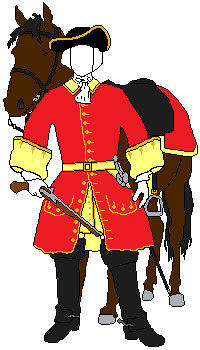
Drabants 1701 |
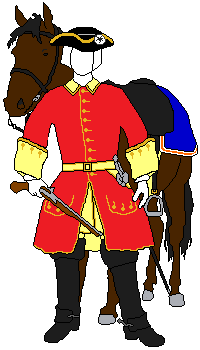
Drabants 1707 |
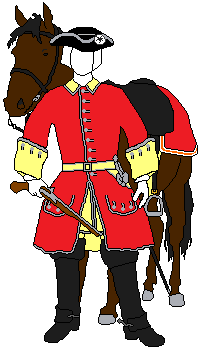
Drabants ca 1710 |
According to Schorr, the Drabants in 1693 had a red coat richly
decorated with gold. In 1701, the coat was red with leather-coloured
(buff) facings and lining. The shabraque had the same colours. Initially
in 1707, the coat was carmoisen-red with leather-coloured cuffs, and a
moose-skin koller. In addition, they had a carmoisen-red cloak.
The shabraque was blue with aurora-white edge. Later, the cuffs and
collar were paille-coloured (straw-coloured) and the leather vest was
replaced with a paille-coloured cloth vest. The shabraques became
carmoisen-red and the coat was decorated with black velvet mixed with
silver and silver-plated buttons and buckles. The trumpeters had yellow
coats with bleumerant (light blue) cuffs and lace in bleumerant and
silver. In 1715, new uniforms were issued. The coat was then still carmoisen-red but all the silver had been replaced with gold.
Höglund, on the other hand, writes that the drabants had pale yellow
coats with silver buttons as well as cuffs, lining, vest, breeches and neckcloth in red. Even the cartridge box belt were red with silver lace.
The hats had white lace with a blue-yellow feather bush. Could Höglund's
uniform be a buff coat (koller) that could be worn instead of the
cloth coat?
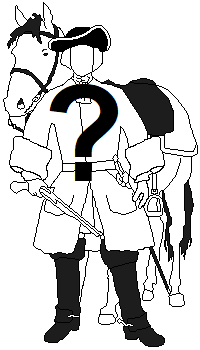
Carabiniers |
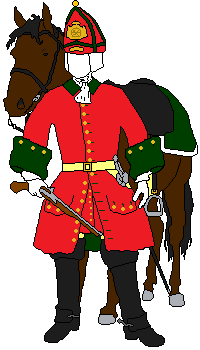
Horse Grenadiers 1703 |
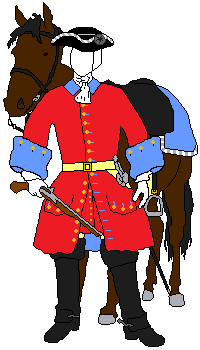
Dragoons 1703 |
Schorr states that there is no information about the carabiniers'
uniform, but he guesses that it was the same as that of the drabants.
Höglund, on the other hand, states that it is the dragoons' uniform that
is unknown, while his description of the carabiniers' uniform is similar
to Schorr's description of the dragoons. It appears that someone has got
the corps mixed up. Höglund mentions that the carabiniers had a
hat with gold lace, a crimson coat with brass buttons, pale blue lining
and cuffs, a pale yellow vest with pale blue lace, and pale yellow
breeches. The shabraque was pale blue with one wide and one narrow edge,
monogram and crown in gold.
According to Schorr, the dragoons in 1703 had a red coat with cuffs,
lining and collar in bleumerant. The buttons were yellow (brass or gold),
the vest red and the breeches made of leather. The hat was a tricorne
with white and silver lace and a white cockade. The shabraque and pistol
covers were medium blue with white and silver trim.
According to Schorr, the horse grenadiers had red coats with dark green
facings, lining and collar, as well as a red vest, leather breeches and
a white neckcloth. The grenadier cap was stiff and red with dark green
trim and fitted with a brass plate (which, according to Höglund,
contained the coat of arms of Saxony and the text "GUARDE"). The
shabraques were dark green with a white trim.. According to Höglund, the
white trim of the shabraque and the pistol covers had a wavy line. He
also deviates from Schorr by stating that the breeches were red.
In 1700, according to Höglund, the standard was white with gold
embroidery and fringe in gold and crimson (Leib-Trabantengarde?). Three months after the merger in 1703, old standards were distributed to other
regiments. These consisted of four green, two lemon yellow and one blue
standard. Instead of these, the Lifeguard received eight new red
standards with silver embroidery. |
|
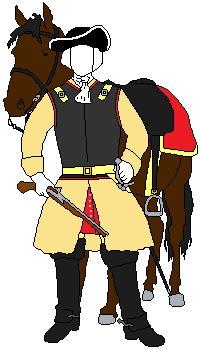 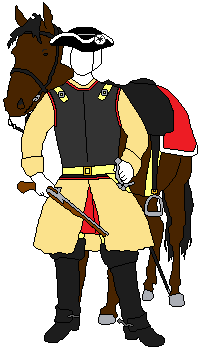
Cuirassiers
Cuirassiers wore both cloth
coats and buff coats (koller) throughout the Great Northern War. In
the battles, they probably wore buff coats and not cloth coats, although
Swedish battle paintings only depict Saxons with cloth coats (the Swedes
left their buff coats at home when the war broke out in 1700).
Details of the
individual regiments' buff coats are unknown except for the
Leibregiment. Therefore, see the general description above for how the
buff coats may have looked like in the various regiments. |
|
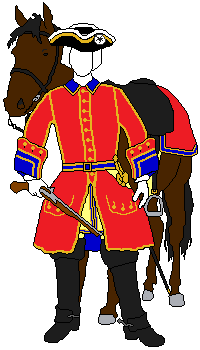
Chevaliergarde
This unit, which was formed on 30 July 1703, was inspired by Charles
XII's Drabant Corps. It consisted of 180 men, all officers.
Daniel Schorr describes the uniform as follows (without specifying the
year):
The coat was red with blue lining and gold buttons and edged with gold
lace. The pocket flaps were horizontal with three buttons and they too
were edged with gold. The cuffs were red over blue and edged with gold
lace.
Red vest, leather breeches and white neckcloth, The carbine belt was
made of buff leather but covered with blue cloth and edged with gold
lace. Tricorne hat with gold lace and white feathers and a white cockade
on the left side. The sword scabbard was black with gold fittings.
The shabraque was red trimmed with gold-blue-gold and the king's crowned
monogram in gold in the outer corners. The pistol covers were red with
the same trim as the shabraque and a white Maltese cross.
Lars-Eric Höglund specifies the blue colour of the lining to be dark blue
(Schorr has depicted it as light blue) and the monogram to the letters AR under a crown. He deviates from Schorr by stating that the vest was
made of leather and decorated with gold and violet lace. However, Schorr
contradicts himself by depicting the Chevalier Guard with a leather vest
(with the same type of lace as the shabraque).
According to Höglund, the standard was white with gold embroidery and
fringe in gold and crimson. In 1711 they had four blue standards with
gold embroidery.
Fraustadt 1706, Kalisz 1706. |
|
Leibregiment zu Pferde
("Life Regiment on Horse", raised in 1675)
Both Höglund and Schorr
state that they had white facings. But the
former mentions pewter buttons while Schorr (referring to the year
1707 for his information) writes that they were to have brass buttons. Schorr also mentions that this regiment traditionally had buff coats
with red facings, although in his colour plates it is only the buff coat
from 1707 that have red edges while the one from 1701 has none. The shabraque was red with a white edge and inside
that edge there were a blue stripe. No one mentions the colour of the neckcloth, but Schorr has depicted them with a black neckcloth together
with the buff coats and a white neckcloth with the cloth coat. According
to a Danish source from 1715, the regimental colour was then still
white.
The standard was in 1700 white. Two old red standards
with gold embroidery were issued in 1704 as replacements for losses. In
1709, the regiment was granted money to purchase eight white standards with
embroidery in gold and silver and the Polish-Saxon coat of arms.
Düna 1701, Kliszow 1702, in the Emperor's service November 1702 to May 1704, Posen 1704,
Warsaw 1705, Kalisz 1706, Tönning 1713, Stralsund
1715. |
|
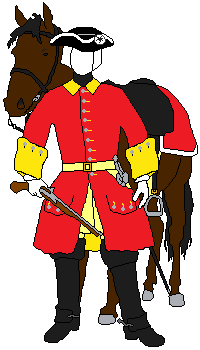
1707 |
Kurprinz
Schorr states that they had yellow facings, pewter buttons and black neckcloths in
1707. Höglund also mentions that they had black lace on their hats (probably
a confusion with the neckcloth which he does not mention).
Lemon yellow standard with silver embroidery and
fringe in silver and crimson. In 1709, the regiment was granted money to
purchase eight yellow standards with gold and silver embroidery and the
Polish-Saxon coat of arms.
This regiment which was raised in 1680 was called
before 1700 "La Forêt" (La Forest). According to Höglund, it changed its
name to "Crown Prince" in 1713, but according to Schorr, it changed its
name to "Königl. Prinz" in 1717.
Düna 1701, Kliszow 1702, in the Emperor's
service November 1702 to May
1704, Posen 1704, Warsaw 1705, Kalisz 1706, Gadebusch 1712, Tönning
1713, Stralsund 1715. |
|
|
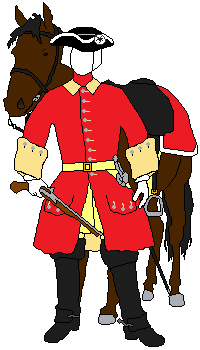
1707 |
Königin
("Queen's Regiment")
Straw yellow facings and pewter buttons. Schorr mentions that the neckcloth was red in 1707 and Höglund mentions that the hats had red
lace (probably a confusion with the neckcloth which Höglund does not
mention).
Pale
yellow standard with gold embroidery and fringe in gold and crimson. As
replacement for losses, in 1704 it received an old white standard with
silver embroidery and silver fringe and two red crossed swords as motif
(the Elector's coat of arms). In 1709 the regiment was granted money to
purchase eight paille standards.
Raised in 1680.
Düna 1701, Kliszow 1702, Pultusk 1703, Warsaw 1705, Kalisz 1706, Gadebusch 1712, Tönning 1713, Sandomir 1715.
|
|
 |
Banér
(1699-1701)
Jordan
(1701-1704)
Unknown uniform.
The
colour of the known standards does not give any clue to what the uniform
may have looked like because in 1704 they were issued five older
standards with different colours. One was yellow with silver embroidery.
The others had gold embroidery and consisted of a red, a green and two
yellow standards. All had Johann Georg IV's monogram as a motif, which
means that they were from the period 1691-1694.
Existed 1689-1704
Kliszow 1702,
in the Emperor's service November 1702 to May 1704.
|
|
|
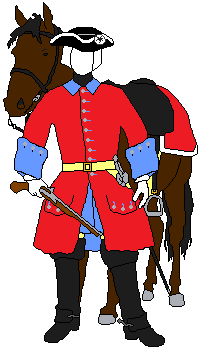
1707 |
Steinau
(1699-1706)
Damitz
(1706-1713)
Johnston
(1713-1715)
Damitz
(1706-1713)
Zühlen (1715-1717)
Criegern (1717-)
Bleumerant (pale blue) facings and pewter buttons. Schorr mentions
that the neckcloth was black in 1707 and Höglund mentions that the hats
had black lace (probably a confusion with the neckcloth which Höglund
does not mention).
In
1709, the regiment was granted money to purchase eight bleumerant
standards.
Raised in 1694.
Kliszow 1702, Pultusk 1703 (?), Warsaw 1705, Gadebusch 1712,
Tönning 1713, Sandomir 1715. |
|
|
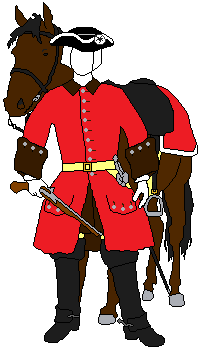
1707 |
Reichenau
(1700-1702)
Eichstädt (1702-1716)
Wolffersdorf (1716-)
Höglund writes that the facings were coffee brown,
the buttons were of pewter and the hats hade white lace. Schorr also
mentions that they had coffee brown facings in 1707 and that the
neckcloth was white.
Höglund states that the standards were cinnamon
brown and that they received eight new grey standards in 1709. The
latter could be a sign of a change of the uniform colour.
Raised in 1698.
Kliszow 1702, in the Emperor's service November 1702 to May 1704, Posen
1704, Warsaw 1705, Kalisz 1706, Tönning 1713, Stralsund 1715.
|
|
|
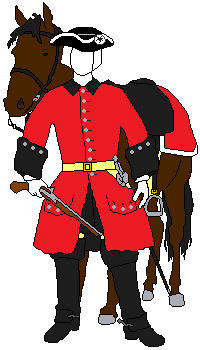
1707 |
Beust
(1702-1706)
Reitzenstein (1706-1712)
Moritz von Sachsen (1712-)
Black facings. Höglund mentions that they had
pewter buttons and white lace on the hats. Schorr mentions that they had
white neckcloths in 1707.
In
1709 the regiment was granted money to purchase eight black standards.
Raised in 1702.
Pultusk 1703, Punitz 1704, Fraustadt 1706, Kalisz 1706, Sandomir
1715. |
|
|
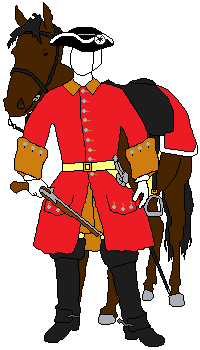
1707 |
Tiesenhausen
(1702-1704)
Gersdorff (1704-1706)
Winckel (1706-1713)
Althahn (1713-1714)
Kyau (1714-1715)
Arnstädt (1715-)
Höglund states that they had cinnamon brown facings. Schorr notes
that they in
1707 grey facings but with cinnamon in parenthesis. Schorr also mentions
that they had pewter buttons.
As
replacements for losses, in 1704 it received two old yellow standards
with silver embroidery and silver fringe
Raised in 1702.
Pultusk 1703, Posen 1704, Warsaw
1705, Kalisz 1706, in the service of the Maritime Powers 1707-1713, Sandomir 1715. |
|
|
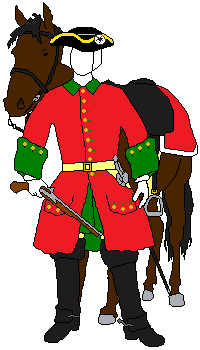
1707 |
Flemming (1703-1706)
Prinz Alexander (1706-)
Green facings. Höglund says that they had pewter buttons and white lace
on the hats. Schorr says they had brass buttons and white neckcloths in 1707.
Green standards with gold
decoration and fringe in gold and crimson. As replacements for losses,
the regiment received in 1704 two old green standards with silver
embroidery and silver fringe. In 1709 the regiment was granted money to
purchase a green standard.
Raised in 1703.
Kalisz 1706, Gadebusch 1712, Tönning 1713, Sandomir 1715. |
|
 |
Sachsen-Meiningen
(in Saxon service 1711- 1717)
Schorr has no information about this regiment but Höglund
have them with red coats and probably green lining and cuffs.
Unknown standard.
Participated in the War of the Spanish
Succession in the service of the Maritime Powers. Sandomir 1715. |
|
 |
Wiedemann
(Existed in 1704?)
Unknown uniform.
In
1704, four old standards were issued. Three of the standards were blue
with gold embroidery and the fourth was green with silver embroidery.
All had Johann Georg IV's monogram as a motif, which means that they
were from the period 1691-1694.
Höglund believes that this was a temporary unit
consisting of recruits. The unit is only known because four standards
were issued to it in 1704. Schorr believes that Wiedemann may have been
merely the name of the officer who received the standard from the
Dresden arsenal. There was a captain named Wiedemann, but his regimental
affiliation is unknown. |
|
|
Dragoons |
|
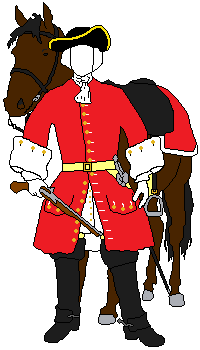
1701 ? |
Leibregiment Dragoner
("Life Regiment Dragoons")
Schorr mentions that in 1707 they had white
facings and brass buttons. He has also depicted them with red shabraques
and pistol covers edged with white. According to a Danish source from
1715, the regimental colour was still white.

White color with gold fringe (according to Höglund)
Existed 1671- 1717. The men transferred to Bielkes regemente (DR 4).
Düna 1701, Kliszow 1702, Pultusk 1703 (?), Warsaw 1705, Kalisz
1706, in the service of the Maritime Powers 1707-1713, Stralsund 1715.
|
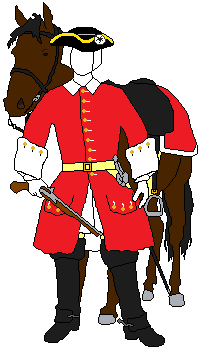
1707 & 1715 |
|
|
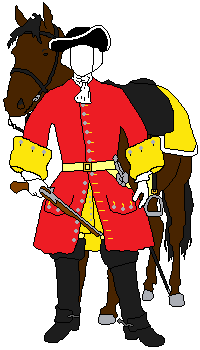
1701 |
Kurprinz
Lemon yellow facings.
Unknown colour.
Existed 1689-1702.
The men were transferred to Garde du Corps.
Kliszow 1702. |
|
|
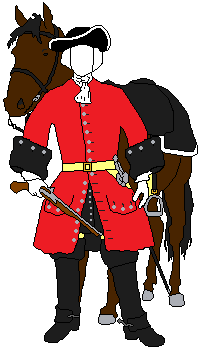
1700 |
Wolffenbüttel
(1700-1701)
Milchau (1702-)
Höglund notes that the facings were black and that they had pewter
buttons and hats with white lace. Schorr also mentions that they had
pewter buttons and that the facing colour was black in 1700. But
according to him the facing colour was changed to yellow in 1701. For
the latter uniform, Schorr has depicted the shabraque and pistol covers
yellow with a white edge.
Unknown colour.
Raised in 1698.
Düna 1701, Kliszow 1702, Pultusk 1703,
Warsaw 1705, Kalisz 1706, in the service of the Maritime Powers 1707-1713, Sockel 1716. |

1701 |
|
|
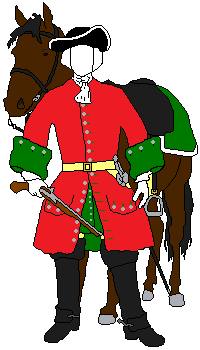
? |
Goltz
(1699-1712)
Flemming
(1712-1715)
Bielke
(1715-)
According to Höglund, the regiment had parrot green facings, white neckcloths and white hat lace. According to Schorr, they had in 1707
black facings, brass buttons and white neckcloths.
It is curious that Höglund and Schorr have such conflicting
information about this regiment. But if the regimental colour was
changed at some point then both could be correct. The question is then
which point in time Höglund's
undated information refer to. Was it before or after 1707?
Unknown colour. Raised in
1699. |
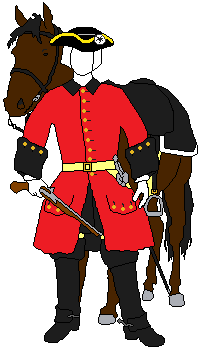
1707 |
Düna 1701, Kliszow 1702, Pultusk 1703, Warsaw
1705, Fraustadt 1706, Kalisz 1706, Prosna 1716. |

Stammer
Raised and disbanded in 1701. The men were transferred
to Garde du Corps)
Uniform and colour unknown.
|
|
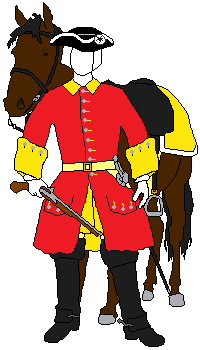
1707 |
According to Höglund, the regiment had yellow facings and vest, pewter
buttons, white neckcloth and white hat lace. Schorr specifies the colour
to lemon yellow and he too mention that the neckcloth was white.
Shabraque and pistol covers are depicted by Schorr as yellow with white
edge.

Lemon yellow colour with silver embroidery (according to Höglund)
The regiment lost four lemon yellow colours to the
Swedes in 1703. Eight new yellow colours were issued on 1 September
1709.
Raised in 1702.
Thorn 1703, Warsaw 1705, Kalisz 1706, Gadebusch 1712, Tönning
1713, Sockel 1716.
|
|
|
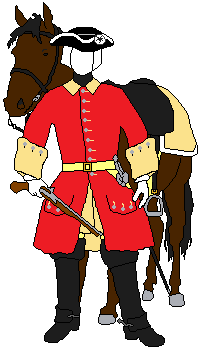
1707 |
Schulenburg
(1702-1710)
Saint-Paul
(1710-1717)
Schorr writes that the facings were straw yellow in 1707 and that the
neckcloth was black. Höglund tells that the facings and vest were pale
yellow, the buttons were of pewter and that both neckcloth and hat lace
were black.
Unknown colour.
Existed 1702-1717. The men were transferred to DR
3.
Pultusk 1703,
Warsaw 1705, Kalisz 1706, Tönning 1713, Sockel 1716. |
|
|
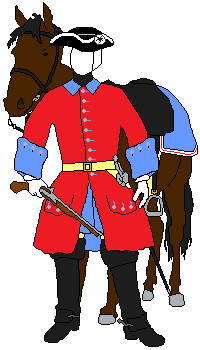
1707 |
Brandenburg-Bayreuth
Schorr mentions that the
facings were bleumerant in 1707 and that they had pewter buttons and
white or black neckcloths. Höglund describes the facing colour as light
blue and notes that the vest was also of that colour. Apart from pewter
buttons he also mentions that the hat had black and white lace (yet
again the same colours as Schorr's neckcloths so likely a mix-up with
these). Schorr has depicted the regiment's shabraques and pistol covers
in blue with a white edge containing an inner red stripe.
Unknown colour.
Existed 1703-1717. The men were transferred to DR 9.
Posen 1704, Punitz 1704, Fraustadt 1706, Gadebusch 1712, Tönning
1713. |
|
|
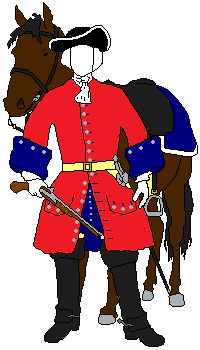
1704 |
Oertzen
(1703-1705)
Dünewald
(1705-1712)
Weissenfels
(1712-)
Höglund states that the regiment
had blue facings in 1703 but Schorr writes that it was first in 1704
that they received red coats with blue facings. The year before, the
coat was blue with an unknown colour on the facings. Also of interest is
information from Rehnsköld in 1704 that Augustus the Strong had uniforms
made "in the Swedish manner" whereby Saxons are said to have
appeared with blue coats with small cuffs and white lace on their hats
(Bellander p. 224). This could be referring to Oertzen.
Both Höglund and Schorr agree that
the regiment had pewter buttons, white neckcloths and that the facings
colour was changed to green in 1707. Höglund specifies the colour to
light green and notes that the vest was also of that colour and that the
hat lace was black. |
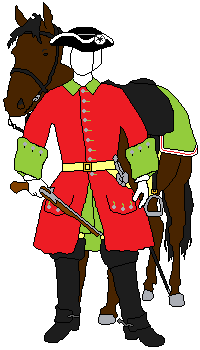
1712 |
Schorr
has depicted the shabraque and pistol covers as green with a white edge in
1707. This could then have been changed in 1712 so that an inner red stripe
was added to the white edge.

Dark blue colour with silver embroidery |

1704: One white and five red old colours |
During
the campaigns of 1702-1703, Oertzen's regiment is said to have lost five
blue colours to the Swedes. Höglund describes them as dark blue with silver
embroidery. As a replacement for the lost colours, in 1704 one white and
five red colours were obtained. On September 1, 1709, eight new green
colours were distributed (according to Höglund with silver embroidery).
Raised in
1703.
Posen 1704, Punitz 1704, Fraustadt 1706, Gadebusch 1712, Tönning
1713, Sockel 1716. |
|
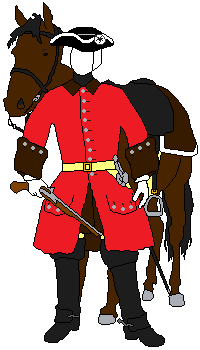
1707 |
Wrangel
(1704-1710)
Baudissin
(1710-)
Schorr mentions that the
facings were coffee brown in 1707 and that the neckcloth was black.
Höglund adds that the uniform in 1707 had pewter buttons, coffee brown
vest and black hat lace (the hat lace colour is probably a mix-up with
the neckcloth mentioned by Schorr).
Unknown colour.
Raised in 1704.
Fraustadt 1706, Gadebusch 1712,
Tönning 1713. |
|
|
Short-lived Units
|

Flemming
(Existed 1704-1707)
Unknown uniform and
colour.
Warsaw 1705, Fraustadt 1706. |

Fürstenberg
(Existed 1704-1707)
Unknown uniform and colour.
Fraustadt 1706.
|

Jordan
(Existed 1704-1707)
Unknown uniform and colour.
Fraustadt 1706.
|

Winckel
(Existed 1705-1706)
A temporary unit created in 1705 by
recruits intended for the main army's regiments. According to Höglund it
had probably not been issued regular uniforms and was instead likely
dressed in grey fatigues.
Fraustadt 1706. |
|
|
Ansbach-Feilitzen
(1709-1717)
Ansbach-Flemming (1717-1718)
Baudissin's
Carabiniers
(1718-)
|
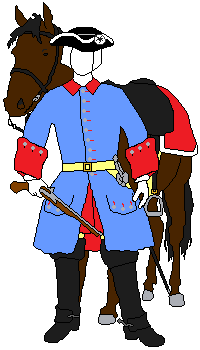
According to Höglund |
This was a regiment hired from Ansbach in 1709.
According to Höglund, they wore a blue coat
with red cuffs and pewter buttons. Which appears to be the same uniform
as that of the Ansbach regiment below whose blue colour is specified as
bleumerant by another source.
Schorr also mentions pewter buttons but he
describes a red coat with blue cuffs for Flemming's regiment (perhaps a
later uniform?) Schorr has also depicted this uniform together with red
shabraques and pistol covers.
Unknown colour.
Tönning 1713, Stralsund 1715, Stresow 1715, Prosna 1716. |
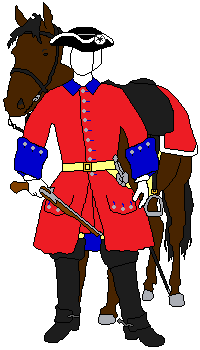
According to Schorr |
|
|
Ansbach-Schmettau
|

According to Höglund |
A regiment from Ansbach that was in Saxon service
1713-1717.
According to Höglund, they had a blue coat with
pewter buttons as well as cuffs, lining and vest in carmine red. In
addition, leather breeches and a carmine red coat with white edge. Which
appears to be the exact same uniform as the previous Ansbach regiment. A
Danish source from 1715 seems to confirm Höglund ("bleumerant und
Roth").
Schorr deviates by writing that the coat was light
grey and the shabraque crimson (although he mentions that they were
possibly blue). He also adds that the sneckcloth was black and the hat
had white lace. NCOs are said to have had silver lace on their cuffs and
the drummers had crimson coats with light grey cuffs and linings and
crimson breeches. The officers also had grey coats with crimson cuffs
and linings. But buttons, buttonholes and seams were decorated with gold
lace. In addition, they had a black sash adorned with silver thread as a
sign of rank. Their neckcloth was white.
Stralsund 1715, Prosna 1716. |
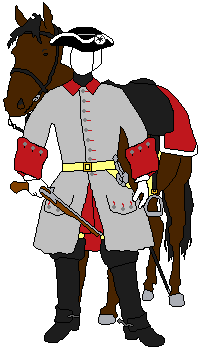
According to Schorr |
|
|
Battle Paintings

A detail of Daniel Stawert's
battle painting from 1707 of the Battle of Düna that hangs inside
Drottningholm Palace.
Daniel Schorr also mentions a battle painting from 1707 depicting the Battle
of Düna which he believes depicts the Queen's cuirassier regiment (Königin)
in red coats with turnbacks and the regimental colour on the cuffs and
lining. However, it is not entirely clear which battle painting he is
referring to as it was Daniel Stawert who in 1707 painted the most famous
battle painting of this battle, but the uniforms in this do not match Schorr's description. I can only find one Saxon cavalryman with turnbacks,
and he is wearing a grey coat, and no one match the Queen's colour
combination. In addition, the cuirassiers have cuirasses over the coat which
they would not have according to Schorr.
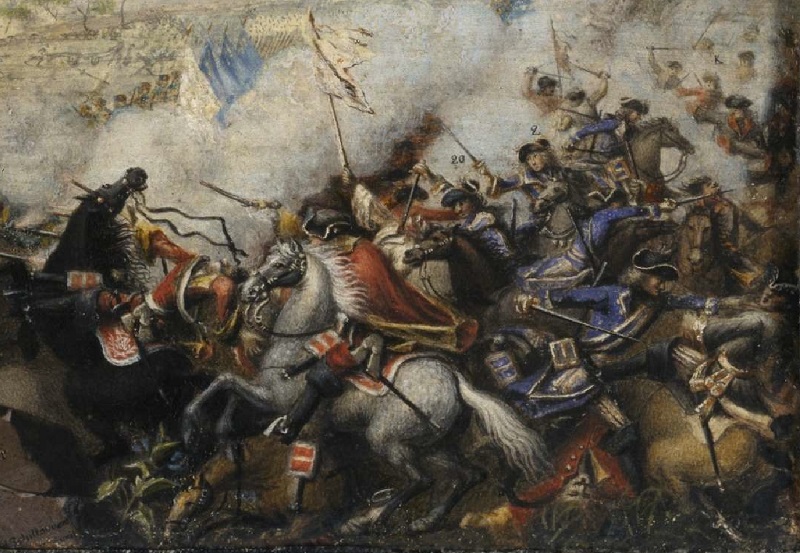
Detail from Henrik Schildt's painting of the Battle of Düna.
The
second battle painting was made by Henrik Schildt (1678-1732) but the year
when it was made is as far as I know unknown. There we do have Saxon
cavalrymen with the Queen's colour combination and what appears to be
cuirasses under the cloaks as well as turnbacks. But it also shows tricornes,
which probably means that the whole painting can be considered anachronistic.
It is not
known which sources Henrik Schildt used, but we know that Daniel Stawert
used Johan Lithén's drawings. Lithén did take part in the Battle of Düna, but his drawings were black and white and the details are very small. Better
information about Saxon uniforms than the excerpt below cannot be obtained
from Lithén's drawing. Therefore, the battle paintings cannot be used as
proof that Saxon cuirassiers had red cloth coats instead of buff coats
during the Battle of Düna.
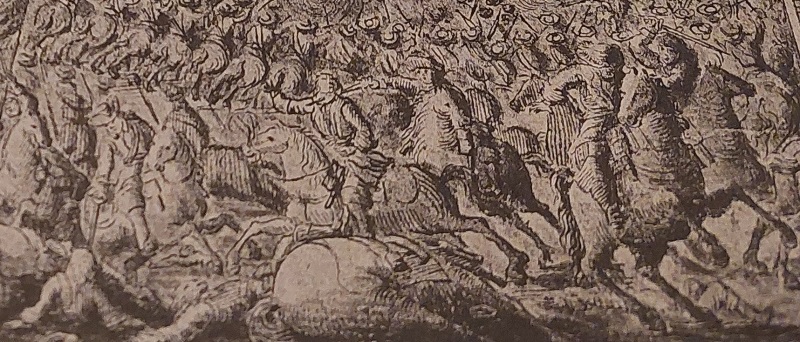
Detail from Johan Lithén's drawing of the Battle of Düna.
Read also:
Campaigns of the Saxon Army,
Saxon army organisation,
Infantry uniforms,
Artillery
uniforms. |
|
References
Bellander, Erik.
Dräkt och uniform. Stockholm (1973)
Höglund, Lars-Eric – Sallnäs, Åke – Bespalov, Alexander. Stora
nordiska kriget 1700-1721, III. Karlstad (2004).
Qurengasser, Alexander. The Saxon Army in the Great Northern War.
(article in GNW-C). St. Louis (2015)
Schorr, Daniel. Notes
on the Saxon Army 1700-1716.
(2008) * GNW-C = Great Northern War Compendium with Steve Kling as editor.
* = an article published on the now defunct website
www.northernwars.com
"The Danish source from 1715" was conveyed
to me by Magnus Lindskog and a picture of it can be found at
this link. |
|

